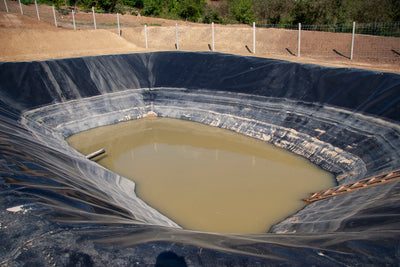Water Quality InformationWritten By Actual Experts
RSSDrinking Water Supplies Risk Contamination from Toxic Wastewater Ponds

Drinking Water Problems in the Tampa Bay Region of Florida

Christina Liu, B.S. | Hydroviv Science Team
Tampa Bay Water is an alliance between the six governments in west-central Florida: Hillsborough County, Pasco County, Pinellas County, New Port Richey, St. Petersburg and Tampa. These municipalities, in turn, provide drinking water to more than 2.5 million people in the Tampa Bay region. For Hydroviv’s assessment of Tampa Bay Region’s drinking water, we aggregated water quality test data from Tampa Bay Water, the 6 municipal suppliers listed above, the U.S. Environmental Protection Agency (EPA), the Environmental Working Group, and the US Geological Survey. Our Water Nerds then cross referenced these data with toxicity studies in the scientific and medical literature, as well as upcoming regulatory changes. The custom water filters that we build for our customers in the Tampa Bay Region are optimized with this research in mind.
Source of the Tampa Bay Region’s Drinking Water
Tampa Bay Water’s supply is a blend of treated groundwater, river water and desalinated seawater. Groundwater comes from 12 wellfields pumping water from the Floridan Aquifer. River water is withdrawn from the Alafia River, Hillsborough River and the Tampa Bypass Canal. Surplus river and canal water is stored in the C.W. Bill Young Regional Reservoir, which supplies the surface water treatment plant during dry times. Hillsborough Bay is the source of seawater for the Tampa Bay Seawater Desalination Plant.
What Are The Major Concerns in Tampa Bay Drinking Water?
Contaminants of concern in the Tampa Bay Region’s drinking water include Lead, PFAS, Disinfection Byproducts, Radium, and Uranium. Low amounts of Arsenic and Chromium 6 were also detected in the water. Chloramine is used to disinfect the water.
Lead In Tampa Bay Region’s Drinking Water
Lead enters into the consumer's tap water through old lead service pipes and lead-containing plumbing. When corrosion control measures fail (as witnessed in Flint, Michigan), lead leaches into the drinking water, reaching toxic levels. 2020 lead sampling by Tampa Bay Water detected levels as high as 4 parts per billion. EPA, CDC and the American Academy of Pediatrics all recognize that there is no safe level of lead for children. In addition, Federal regulations cannot take into account levels measured at an individual tap.
PFAS or 'Forever Chemicals' in Tampa Bay Water
Per and Polyfluoroalkyl Substances (PFAS) are a category of emerging contaminants commonly used in firefighting foam, Teflon, non-stick surfaces, stain-resistant surfaces, and food packaging. The Agency for Toxic Substances and Disease Registry (ATSDR) has determined that PFAS exposure is associated with various adverse health effects, including an increased risk of cancer, lowered fertility rates, and developmental issues in infants and young children. A new study out of The Yale School of Public Health recently found that exposure to PFAS increases the risk of miscarriage by 80-120% in pregnant women. The Centers for Disease Control also issued a disclosure regarding a potential intersection between PFAS and COVID-19.
Even small amounts of PFAS are extremely toxic. PFAS are measured in parts per trillion, and one part per trillion is equivalent to one drop of water in 20 Olympic-sized swimming pools.
PFAS have been detected in a growing number of municipalities across the United States. Most municipalities are not required to test for or remove PFAS from drinking water, including the Tampa Bay Region. Not all water filters are designed to remove PFAS from tap water. If you'd like to find water filters that remove PFAS from tap water, check out this Duke/NC State PFAS study. Hydroviv filters are NSF/ANSI Standard 53 certified for PFOA/PFOS removal.
Disinfection Byproducts (DBPs) In Tampa Bay Drinking Water
DBPs are a category of emerging contaminants that form when chlorine-based disinfectants (added to the water supply to protect consumers) react with naturally-occurring organic matter. EPA regulates two categories of DBPs: Total Trihalomethanes (TTHMs) and Haloacetic Acids (HAA5). The EPA has stated that DBPs have been associated with increased risk of bladder cancer, as well as kidney, liver, and central nervous system problems. Haloacetic Acid levels in Hillsborough and Pinellas County ranged as high as 47.2 parts per billion, nearing the EPA Maximum Contaminant Level of 60 parts per billion. Total Trihalomethane levels ranged as high as 107 parts per billion, exceeding the EPA Maximum Contaminant Level of 80 parts per billion.
Radium and Uranium in Tampa Bay Region’s Drinking Water
Radium is formed when uranium and thorium undergo radioactive decay in the environment. Two of the main radium isotopes found in the environment are radium-226 and radium-228. Radium in drinking water is of primary concern because this radiation may cause cancer, kidney damage and birth defects. Radium levels in Hillsborough County were as high as 2.04 ppb with the EPA Maximum Contaminant Level Goal 5 ppb. Uranium levels in Pasco County water measured at 0.54 ppb in 2019, with the EPA Maximum Contaminant Level Goal set at 30 ppb.
Use Of Chloramine In Tampa Bay Region’s Tap Water
While most cities use chlorine as the primary disinfectant, all of the municipalities within Tampa Bay Water use chloramine, which is made by combining chlorine and ammonia. Chloramine is frequently the issue when customers report a “bad taste” in their tap water, and unlike chlorine will not fade away if left in the fridge overnight. The 2020 chloramine running annual average for the City of Tampa Bay was 3.5 parts per million, with samples ranging as high as 5.3 ppm; the maximum residual disinfectant level, in comparison, is only 4.0 ppm. Most one-size-fits-all water filters use filtration media that don’t adequately remove chloramine, but the filters that Hydroviv builds for Tampa Bay Area water use special filtration media that are purpose-built to remove chloramine as well.
Arsenic in Tampa Bay Region’s Drinking Water
Arsenic is a hazardous heavy metal that can cause cancer and other health problems. Arsenic originates in source water naturally. In the Tampa Bay Water region, low amounts of arsenic were detected in the different areas, ranging from 0.11 ppb to 0.43 ppb. While Tampa Bay Region’s Arsenic levels were comparatively low when measured to EPA water quality standards, consumers should know that the U.S. EPA's standard balances toxicity against the costs of removing arsenic from drinking water.
Chromium 6 Levels In Tampa Bay Region’s Drinking Water
Chromium 6 is a highly toxic metal that is not regulated by the EPA. Tampa Bay Water was measured to have Chromium 6 levels ranging from 47 parts per trillion to 140 parts per trillion. California has determined that 20 parts per trillion is the contaminant level below which there is minimal health risk. The Chromium 6 levels in the Tampa Bay water system range from about 2 to 7 times the level generally accepted as safe.
How Can Hydroviv Help Me?
Hydroviv is a water filtration company that uses water quality data to optimize water filters for each customer's water. The contaminants that we list above are what we consider to be major “points of emphasis” that we use to build water filters that are built specifically for Tampa Bay Area water, but all of our filters also include broad protection against a wide range of contaminants.
If you’re interested in learning more about water filters that have been optimized for Tampa Bay tap water, or just have questions about water quality in general, feel free to visit www.hydroviv.com, reach out by email (hello@hydroviv.com) or through our live chat. We post water-related news on Twitter, Instagram, and Facebook.
Hydroviv's drinking water filters carry NSF certifications to Standard 42 (aesthetic effects--Chlorine Removal) and Standard 53 (health effects--Lead, VOCs, and PFOA/PFOS removal), and are independently tested to remove hundreds of contaminants.
Recommended Articles For You:Everything You Need To Know About PFAS Contamination in Tap Water
Disinfection Byproducts In Your Drinking Water
Problems We Found With Orlando Drinking Water



